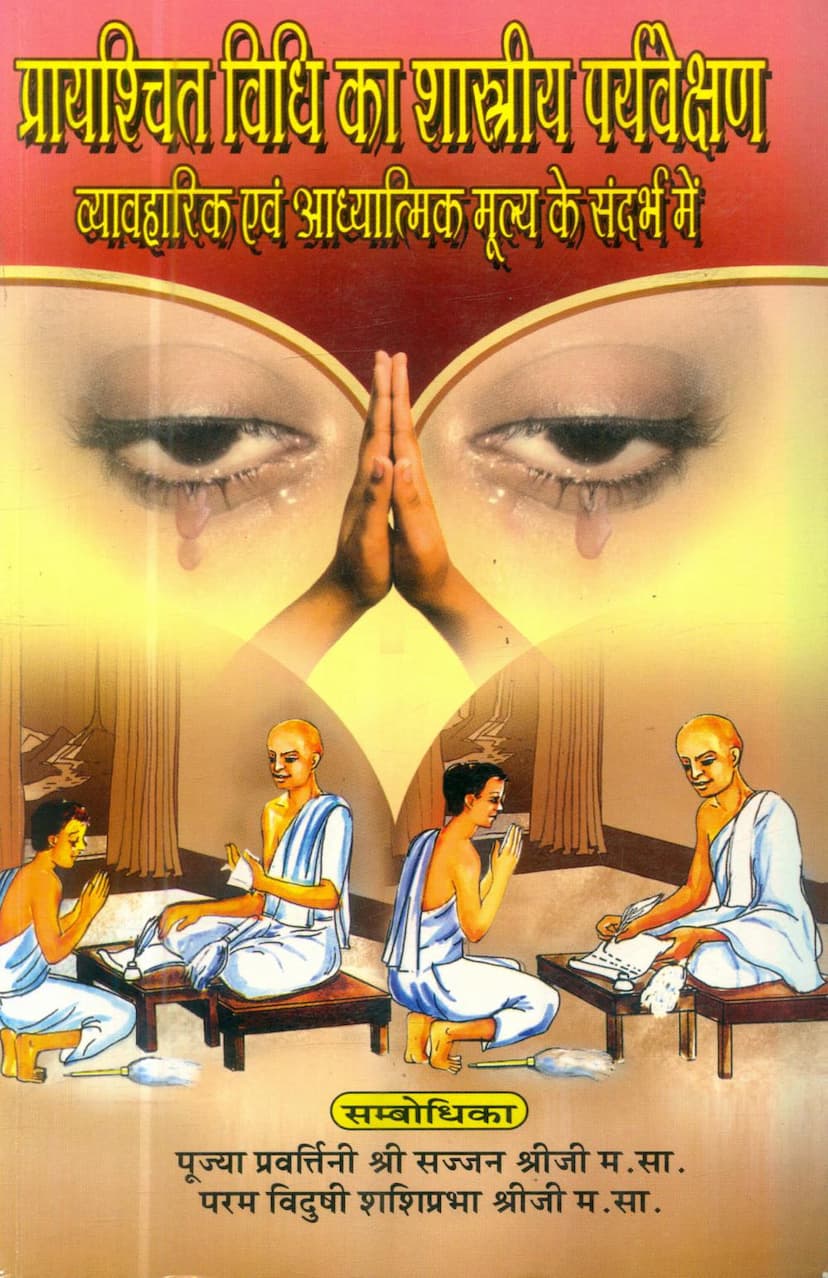Prayaschitt Vidhi Ka Shastriya Sarvekshan
Added to library: September 2, 2025

Summary
Here is a comprehensive summary of the Jain text "Prayaschitt Vidhi Ka Shastriya Sarvekshan" by Saumyagunashreeji, based on the provided pages:
Book Title: Prayaschitt Vidhi Ka Shastriya Sarvekshan (A Scholarly Survey of Penance Procedures) Author: Dr. Sadhvi Saumyaguna Shri (Vidya Prabha) Director/Supervisor: Dr. Sagar Mal Jain Publisher: Prachya Vidyapith, Shajapur (under Sajjan Mani Granthmala) Subject: A Comparative and Critical Study of Jain Legal Provisions concerning Penance Procedures, in the context of their Practical and Spiritual Value.
Overall Theme:
This D.Litt. research thesis, presented in 10 volumes, undertakes a thorough scholarly investigation into the concept and practice of 'Prayaschitta' (penance or expiation) within Jainism. The work aims to analyze the procedural aspects of penance from both a practical (vyavaharik) and spiritual (adhyatmik) perspective, exploring its significance in the life of a Jain follower, whether monastic (shraman) or lay (grihastha).
Key Areas Explored:
The book delves deeply into the multifaceted nature of Prayaschitta, covering the following crucial aspects:
- Meaning and Nature of Prayaschitta: The text begins by defining 'Prayaschitta' by exploring its etymological roots and various interpretations offered by ancient Jain Acharyas. It highlights that Prayaschitta is essentially a process of self-purification and atonement for transgressions against Jain principles.
- Types of Prayaschitta: A significant portion of the research is dedicated to classifying and detailing the various forms of penance. The text enumerates and explains the traditional ten types of Prayaschitta found in Jain scriptures:
- Alochanā (Criticism/Confession): Acknowledging and confessing one's faults.
- Pratikramaṇa (Retrospection/Reversal): Resolving not to repeat the mistake.
- Tadubhaya (Both Alochanā & Pratikramaṇa): Combining confession with the resolution not to repeat.
- Viveka (Discernment/Separation): Distinguishing between right and wrong actions and separating oneself from the wrong.
- Vyutsarga (Renunciation/Kāyotsarga): Renouncing the body and its attachments, or specific actions/possessions.
- Tapas (Austerity): Performing specific penances like fasting, eating once a day, etc.
- Chheda (Cutting off/Suspension): Temporary suspension of monastic privileges or status.
- Mūla (Root/Removal): Complete removal from the monastic order or severe penance.
- Anavasthāpya (Non-re-establishment): A severe penance where the individual is not immediately re-established in the order.
- Pārāṅkika (Excommunication/Final Expulsion): The most severe form of penance, leading to expulsion. The text also notes variations in these classifications between Digambara and Shvetambara traditions, particularly regarding the last two categories.
- Categories of Offenses and Corresponding Penances: The research meticulously outlines which types of offenses, ranging from minor lapses in daily conduct to severe transgressions against the vows, necessitate specific forms of Prayaschitta. This includes detailed discussions on doshas (faults) related to:
- Jñānācāra (Conduct related to Knowledge): Errors in study, teaching, and understanding scriptures.
- Darśanācāra (Conduct related to Right Faith): Doubts in Jain principles, admiration for other faiths, etc.
- Cāritrācāra (Conduct related to Right Conduct): Violations of vows, improper behavior, etc.
- Tapaścāra (Conduct related to Austerities): Lapses in performing austerities.
- Vīryācāra (Conduct related to Effort/Vigor): Lack of diligence or improper application of effort.
- Specific rules for householders (Śrāvaka/Śrāvikā): Penances for lapses in observing vows like Ahimsa, Satya, Asteya, Brahmacharya, Aparigraha, Dig-parimana, Bhogopabhogaparimana, and Anarthadanda Viramana.
- Historical Evolution of Prayaschitta: The thesis traces the historical development of penance procedures, noting how they were initially outlined in the Agamas and later elaborated upon in commentaries and independent works like Vidhimārgaprapā and Ācāradinakar.
- Comparative Study: A significant aspect of the research involves comparing Jain Prayaschitta practices with those found in other Indian traditions, specifically Hinduism and Buddhism. This comparative analysis highlights both similarities and differences in their approaches to penance.
- Authority for Granting Prayaschitta: The text discusses who is qualified to administer penance. Traditionally, only highly knowledgeable and virtuous monks (Gītārtha Munis) have this authority, as they possess the wisdom to assess the gravity of the offense, the offender's state of mind, and the appropriate penance.
- Practical and Spiritual Value: The research emphasizes the practical and spiritual importance of Prayaschitta in maintaining the purity of individual conduct and the overall sanctity of the Jain order (Sangha). It explains how Prayaschitta aids in spiritual progress by purifying the soul, reducing karmic bondage, and fostering a sense of remorse and self-awareness.
- Methodology: The thesis is based on a critical analysis of a wide range of Jain canonical and post-canonical texts, as well as comparative studies of related traditions.
Key Contributions of the Research:
- Comprehensive Documentation: It provides a detailed compilation and systematic analysis of Jain Prayaschitta rituals and principles.
- Clarification of Procedures: The work elucidates the often complex and subtle rules governing the administration of penance.
- Inter-traditional Comparison: The comparative study offers valuable insights into the broader religious and philosophical landscape of India concerning penance.
- Spiritual Guidance: By explaining the underlying spiritual purpose of penance, the research serves as a guide for practitioners seeking self-purification and spiritual growth.
- Scholarly Rigor: The thesis is a testament to extensive research, meticulous analysis, and deep understanding of Jain philosophy and practices.
Personal Touches:
The initial pages and acknowledgments reveal the profound dedication of Sadhvi Saumyaguna Shri, who spent seventeen years on this extensive research. The work is also a tribute to her spiritual mentors, particularly Pravartini Shri Sajjan Shri ji M.S. and the highly knowledgeable Sadhvi Shri Shashiprabha Shri ji M.S., whose blessings and guidance were instrumental. The publication was also supported by various Jain trusts and individuals, highlighting a collective effort in preserving and disseminating this crucial aspect of Jainism. The extensive list of supporting texts and individuals in the appendices underscores the thoroughness of the research.
In essence, "Prayaschitt Vidhi Ka Shastriya Sarvekshan" is a seminal work that illuminates the vital role of penance in the Jain path to liberation, offering both a scholarly treatise and practical guidance for spiritual seekers.